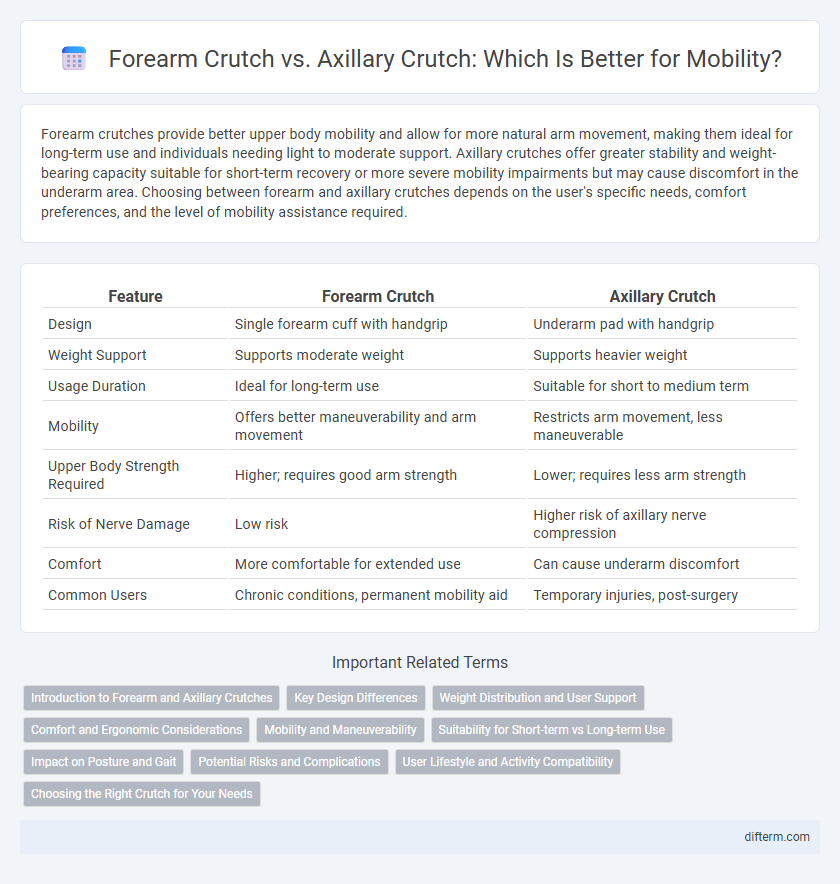Forearm crutches provide better upper body mobility and allow for more natural arm movement, making them ideal for long-term use and individuals needing light to moderate support. Axillary crutches offer greater stability and weight-bearing capacity suitable for short-term recovery or more severe mobility impairments but may cause discomfort in the underarm area. Choosing between forearm and axillary crutches depends on the user's specific needs, comfort preferences, and the level of mobility assistance required.
Table of Comparison
| Feature | Forearm Crutch | Axillary Crutch |
|---|---|---|
| Design | Single forearm cuff with handgrip | Underarm pad with handgrip |
| Weight Support | Supports moderate weight | Supports heavier weight |
| Usage Duration | Ideal for long-term use | Suitable for short to medium term |
| Mobility | Offers better maneuverability and arm movement | Restricts arm movement, less maneuverable |
| Upper Body Strength Required | Higher; requires good arm strength | Lower; requires less arm strength |
| Risk of Nerve Damage | Low risk | Higher risk of axillary nerve compression |
| Comfort | More comfortable for extended use | Can cause underarm discomfort |
| Common Users | Chronic conditions, permanent mobility aid | Temporary injuries, post-surgery |
Introduction to Forearm and Axillary Crutches
Forearm crutches provide greater freedom of movement and are designed with a cuff that wraps around the forearm, offering enhanced control and stability for long-term mobility support. Axillary crutches, positioned under the armpits, deliver robust weight-bearing assistance and are often recommended for short-term use following leg injuries or surgeries. Both types improve mobility but differ in ergonomics, user comfort, and intended duration of use, making selection vital based on patient needs.
Key Design Differences
Forearm crutches feature a cuff that wraps around the forearm, providing better arm support and allowing more freedom of movement, while axillary crutches use a padded top that fits under the armpit for weight bearing and stability. Forearm crutches typically promote a more ergonomic posture and reduce the risk of nerve damage in the underarm area, compared to the higher impact pressure points found in axillary crutches. The design of forearm crutches makes them suitable for long-term use and activities requiring greater mobility, whereas axillary crutches are often preferred for short-term injuries due to their straightforward support structure.
Weight Distribution and User Support
Forearm crutches distribute weight through the forearm and wrist, offering better upper body support and increased mobility for users with long-term or permanent disabilities. Axillary crutches transfer weight to the underarm area, which can cause discomfort and risk of nerve damage with prolonged use but provide greater stability for short-term injuries. Choosing the appropriate crutch depends on balancing the need for weight distribution, user comfort, and the nature of the injury or disability.
Comfort and Ergonomic Considerations
Forearm crutches provide enhanced comfort by distributing weight more evenly along the arm, reducing wrist strain and improving posture compared to axillary crutches. Ergonomic designs of forearm crutches offer adjustable cuffs and grips that accommodate various forearm sizes, promoting natural arm movement and reducing nerve compression risks. In contrast, axillary crutches may cause discomfort due to pressure on the armpits and increased risk of nerve damage, making forearm crutches a preferable option for long-term mobility support.
Mobility and Maneuverability
Forearm crutches enhance mobility by providing better control and weight distribution, allowing for more natural arm swings and increased maneuverability in tight spaces. Axillary crutches offer greater stability but can limit agility and cause discomfort under the arms during extended use. Users requiring long-term mobility support often prefer forearm crutches for improved balance and smoother navigation through diverse environments.
Suitability for Short-term vs Long-term Use
Forearm crutches offer better mobility and comfort for long-term use, reducing risk of nerve damage due to their ergonomic design, making them suitable for chronic conditions and extended rehabilitation. Axillary crutches are typically preferred for short-term use because they provide greater stability and are easier to adjust quickly for acute injuries or temporary impairments. The choice between forearm and axillary crutches depends on the duration of use and the user's physical requirements, with forearm crutches favored for prolonged mobility support and axillary crutches for immediate, short-duration assistance.
Impact on Posture and Gait
Forearm crutches promote a more natural, upright posture by encouraging weight distribution through the forearms and improving balance, which reduces the risk of shoulder and wrist strain. Axillary crutches often cause users to lean forward or hunch, leading to increased pressure on the axilla and potential nerve compression, negatively affecting gait efficiency. Studies indicate forearm crutches support a smoother, more symmetrical gait pattern, while axillary crutches may result in altered stride length and reduced walking speed.
Potential Risks and Complications
Forearm crutches reduce the risk of nerve damage compared to axillary crutches, which can cause brachial plexus compression and resulting numbness or pain in the arms. Axillary crutches often lead to axillary pressure sores and fatigue due to their higher weight-bearing on the armpits, increasing the chances of skin irritation and restricted blood flow. Users of forearm crutches may experience wrist overuse injuries, such as tendonitis, requiring proper technique and ergonomic adjustments to minimize long-term complications.
User Lifestyle and Activity Compatibility
Forearm crutches offer enhanced mobility and arm freedom, making them ideal for users with active lifestyles who require long-term support during activities like walking, hiking, or light sports. Axillary crutches provide greater stability and weight-bearing support, better suited for short-term use or less active individuals recovering from injury or surgery. Selecting the right crutch type depends on the user's daily activity level, needing balance between comfort, endurance, and functional mobility.
Choosing the Right Crutch for Your Needs
Choosing the right crutch depends on factors like user comfort, mobility level, and duration of use. Forearm crutches offer greater maneuverability and are ideal for long-term use, promoting better posture and upper body strength. Axillary crutches provide more stability for short-term or post-surgical recovery but may cause armpit discomfort during extended use.
Forearm crutch vs Axillary crutch Infographic

 difterm.com
difterm.com